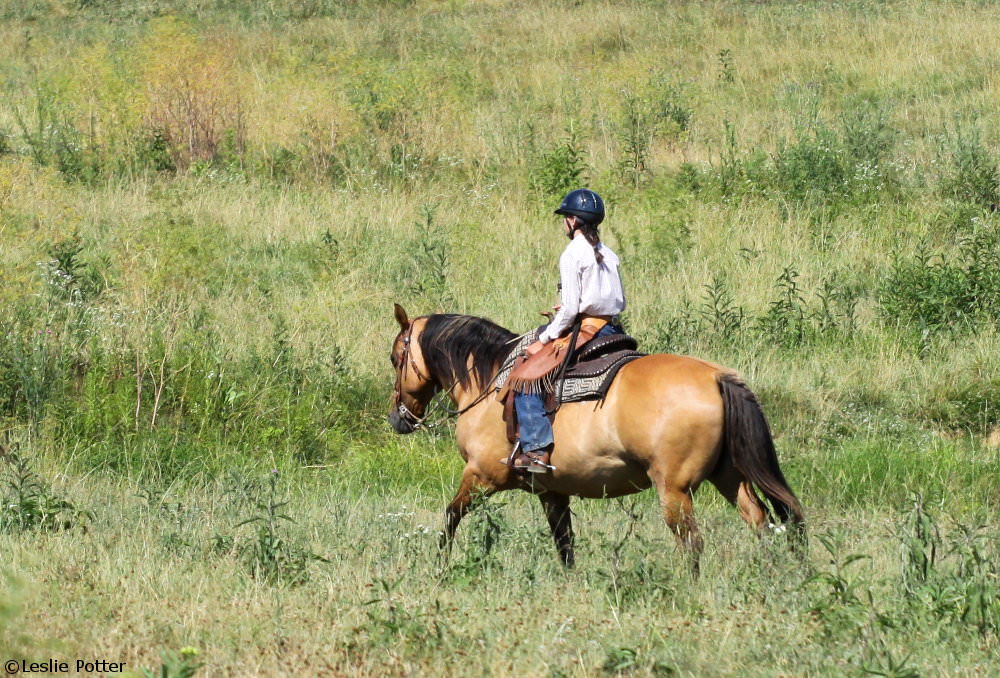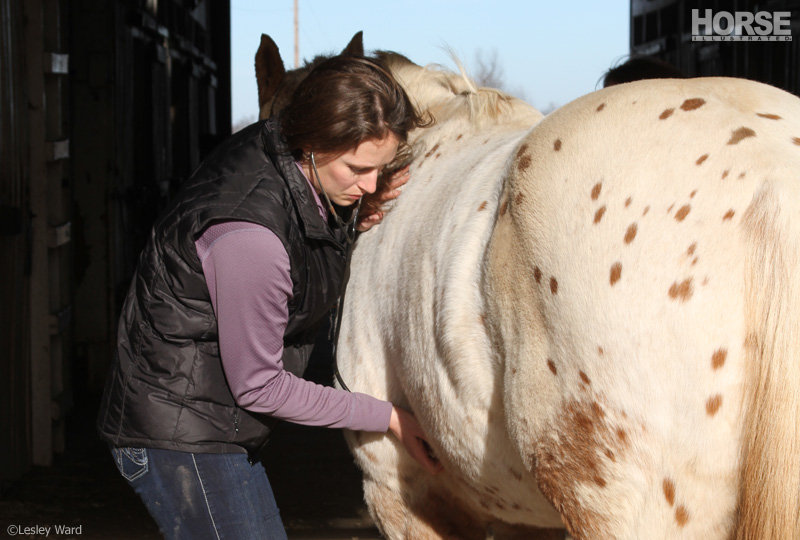Imagine spending Monday through Friday sitting in front of a computer all day, and then going home to lie on the couch and watch TV at night. What do you think would happen if you went on an all-day hike on Saturday? You’d be tired at the end of the day, and sore the next. You may even find that you injured yourself, and end up hobbling around the office come Monday.

The trick to keeping your horse happy and healthy when it comes to exercise is the same as it would be for you: conditioning.
Basic Conditioning for Horses
“Basic conditioning is necessary for the proper maintenance of the mental and physical health of a horse,” says dressage trainer Lisa Scebbi of Diamond Elite Horse Training in Norco, Calif. “A properly conditioned horse has less chance of injury. Correct, consistent workouts also maintain muscle suppleness and joint lubrication.”
Horses that suffer from “weekend warrior” syndrome are at risk for both physical and behavioral issues, according to Scebbi.
“An overworked horse could become physically or mentally damaged, which can cause him to develop negative behaviors,” says Scebbi. “Signs of negative behaviors include irritability when being tacked up or ridden, resistance in transitions from one gait to another, and bucking or rearing.”
By conditioning your horse for the type of riding you’ll be doing, you’ll keep him in good physical and emotional shape.
For the Trail
Trail riding is the most popular equestrian activity; it can also be the most strenuous one for a horse, depending on the terrain, pace, and length of the ride.
“A horse that is asked to negotiate difficult terrain when trail riding will need to have his musculoskeletal tissues strong enough to avoid being injured,” says Nancy Loving, DVM, equine veterinarian of Loving Equine Clinic in Boulder, Colo., and author of Go the Distance. “A lot of how much and to what degree a horse needs to be conditioned depends on the level to which the horse is asked to perform. A casual trail ride of 5 to 10 miles asks for a very different set of circumstances than a 50- or 100-mile endurance ride.
“If an unconditioned horse is asked to perform on difficult, rocky or mountainous terrain and/or at a constant trot and canter, it is possible for the horse to suffer foot bruising, tendon or ligament strain, or metabolic complications,” continues Loving. “If asked to perform in hot and, in particular, humid weather conditions, the horse’s metabolic system may be compromised due to fluid and electrolyte losses through sweat.”
Loving explains that this can lead to a number of problems related to “exhausted horse syndrome,” which include myositis (tying up—muscle stiffness, soreness and cramping), thumps (a spasmodic contraction of the diaphragm), colic, heat stress, and even laminitis.

If you plan to go on a long ride with friends, or just want to start trail riding for several hours at a time, give your horse frequent exercise on a regular basis starting at least two to three months in advance of the event. It’s best not to stop your horse’s conditioning program for weeks at a time, as he will lose fitness. A layup of more than two to three weeks will detract from the fitness you’ve developed to that point.
“Proper conditioning strategies rely on a rider putting in time in the saddle, at least three to five days per week in the initial training phase,” says Loving. “With increasing fitness, and once a strong foundation has been developed, the horse may be ridden only two to three days a week at increased intensity and/or duration. Distance is slowly increased to enable the horse’s [body] to adapt and become more efficient.”
Loving adds that once your horse has a month or so of steady riding and is working at a walk and trot reliably for an hour or two on level ground, you can back down the distance a bit and ask for a little more speed or hill-climbing.
“As the months go by, the horse is then working for longer and longer periods, and at progressively increased speeds or physical demands,” says Loving. “Distance and speed should never be increased at the same time.”
According to Loving, a horse usually needs three to six months of consistent long, slow distance training to be able to withstand an all-day trail ride without ill effect.
“It is important to note that the horse should be conditioned to the terrain he will be asked to ride over during an all-day trail ride. It doesn’t work to train a horse on level, soft ground when the anticipated trail ride will be over hilly, mountainous or rocky terrain.”
“It is important to note that the horse should be conditioned to the terrain he will be asked to ride over during an all-day trail ride,” she says. “It doesn’t work to train a horse on level, soft ground when the anticipated trail ride will be over hilly, mountainous or rocky terrain. And he should be conditioned with the weight on his back that he will be asked to carry. Being trained by a 115-pound rider does not prepare the horse to carry a 200-pound rider, or to be loaded with extra gear on the day of the long ride.”
Naturally, the best way to condition your horse for trail riding is on the trail. Map out a couple of trails in your area that are 5 or 6 miles long. Use a vehicle or a GPS to get an accurate reading. Keep in mind that the average horse walks 1 mile in about 20 minutes and trots it in 9 to 12 minutes. Find out the distance of the ride you’ll be attending so you know how much your horse will be doing that day.
When prepping for an all-day trek, ride your horse three times a week approximately four to six weeks out to build up his conditioning. If you are already trail riding your horse intermittently, go the distance and pace you’ve been doing for the first two weeks, but add in a third day. You can spend time doing arena work or trail riding on the third day—anything that will be fun for your horse and keep him from getting bored.

When you get into week three, add in five minutes of trotting five or six times during the ride. During weeks four and five, continue to add in longer distances at the same pace on one day of riding until you are eventually riding 15 miles in about four hours. The month before your ride, do these longer rides only a couple of times. It’s helpful to know that during training, your horse only needs to be able to cover about 50 percent of the distance he’ll be doing on the full-day ride.
By week six, your horse should be getting fairly fit if you’ve kept to your schedule. If you miss a day here and there in the training, don’t worry about it. Horses are usually athletic and adaptable enough to not have this affect their overall conditioning.
Arena Riding
If you intend to mostly ride your horse in the arena, you need to get him conditioned to the appropriate activity and skill level.
Assuming your horse is sound and healthy and has been getting some regular exercise, you can start with increasing his time under saddle in 15-minute increments each week. For example, if you have been riding him three times a week for 30 minutes each, increase that to three times a week for 45 minutes each time. You can also add another day of exercise to his routine. The more exercise you give him, the more fit he will become. Just remember to add the exercise gradually so you don’t overwhelm him and make him sore or lame.

Pace is important as well. If your horse has only been walking in the arena, you need to add some trotting to his routine. Start with 10 minutes of trotting during each workout in the first week, and add more trotting in five-minute increments in subsequent weeks. Use this same method for building up the canter.
If you have been riding your horse for 30 to 60 minutes two days a week, you need to add at least one more ride during the week. The extra day of riding will help condition your horse slowly instead of putting him through a difficult workout only on the weekends. A horse can build stamina quickly just by being ridden three days a week.
When conditioning a horse, Scebbi points out the importance of understanding that horses have both a strong and a weak side. Working both sides is important to keeping your horse sound.
“Horses are similar to humans who are right-hand or left-hand dominant,” says Scebbi. “There are many riding exercises that can be used in or out of the ring to bridge the gap between the two sides. The newly developed muscle tone ensures that the horse can comfortably carry the rider.”
If you don’t have time to ride as frequently as you’d like to, try to get your horse out at least one more day during the week.
“People have busy schedules, but for a healthy, happy horse, add at least one day in the middle of the week,” says Scebbi. “You can turn out, longe, roundpen, hand-walk or ride. If you cannot get the horse out yourself, hire a responsible trainer who can. Just get that horse moving at least three days a week.”
Pulse and Respiration
An important aspect of conditioning your horse is measuring his pulse and respiration rates. Before you begin conditioning, learn how to read your horse’s pulse and respiration so you can measure his conditioning along the way.
Your horse’s pulse is your key to understanding how efficiently his heart is working during exercise. The key to a well-conditioned horse is a pulse rate that rises to a certain level during exercise and then recovers quickly after the work stops.
Most horses’ pulse rate reaches 100 beats per minute (bpm) when they are exercising, and slows down to the normal post-exercise rate of about 60 bpm after five minutes or so of rest. When 60 bpm is reached, the horse has recovered from the exercise.

To take your horse’s pulse, you can use a stethoscope or just do it by hand. You’ll also need a watch that displays seconds.
Trot your horse for a few minutes and then take his pulse. You should be able to feel it behind his girth on the left side; on the inside of the foreleg; or under the jawbone, below the jowls. It can take some time to locate the beat, so don’t give up; it takes practice to locate on many horses. (Be careful not to use your thumb because you may confuse your own pulse with that of your horse’s.)
When you find the pulse, start counting the beats for 15 seconds. Multiply the number you get by four to calculate your horse’s heart rate in beats per minute. As you work to condition your horse, check his pulse rate weekly to see if he recovers faster as you put more time into his training. The quicker he reaches the 60 bpm rate, the more fit he is becoming.
Respiration is another way to judge if your horse is recovering quickly from a workout. For 15 seconds, measure your horse’s breaths by counting the number of times his flanks expand outward. Multiply this number by four to get his breaths per minute. Before you start your exercise program, measure your horse’s respiration at rest, and then measure it again after a good workout. Check it weekly as you condition to make sure your horse is improving his fitness. The fitter your horse is, the faster his respiration rate will return to normal (10 to 24 breaths per minute) after exercise.
Audrey Pavia is the author of Horses for Dummies and Horseback Riding for Dummies. She lives in Norco, Calif., with her two Spanish Mustangs, Rio and Milagro.
This article originally appeared in the 2015 edition of Your New Horse.






Interesting! I hope that everyone enjoyed their holidays, plus I also hope that their Sunday is going both great and safe!